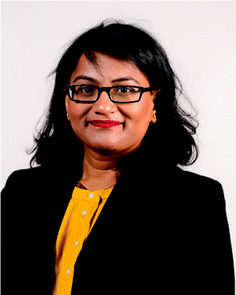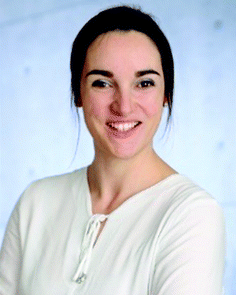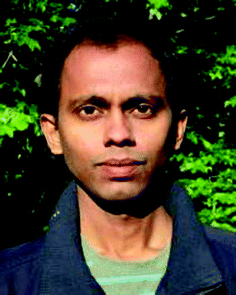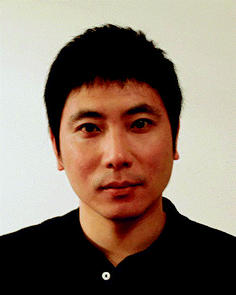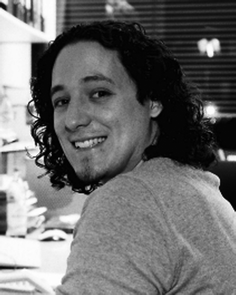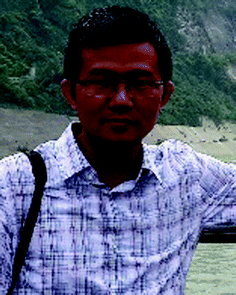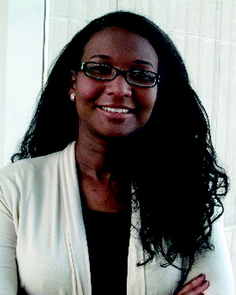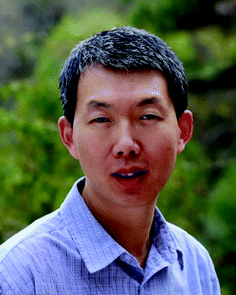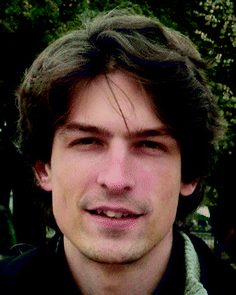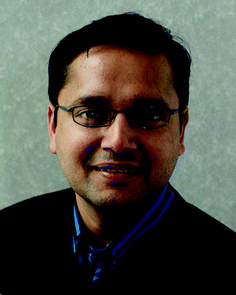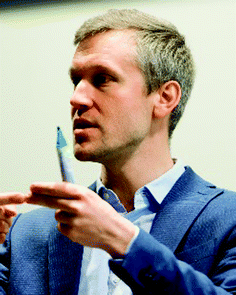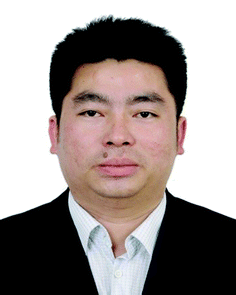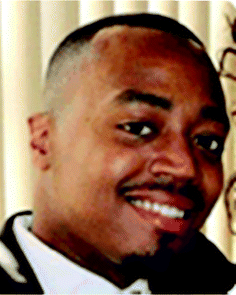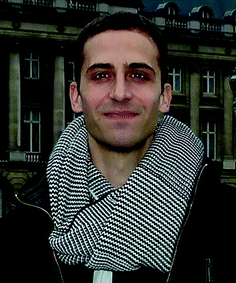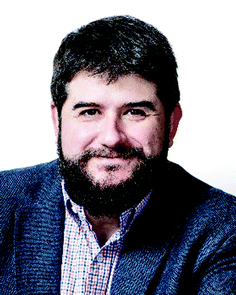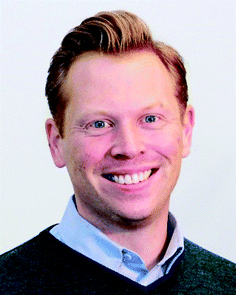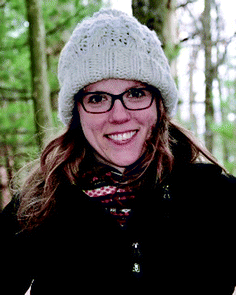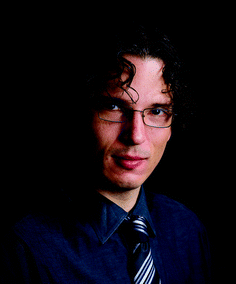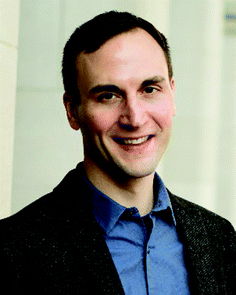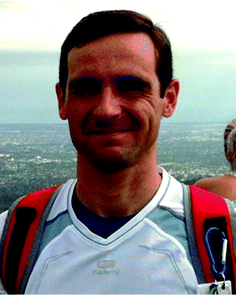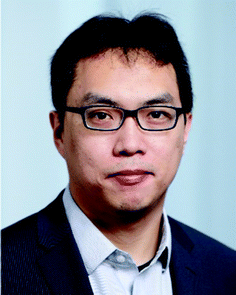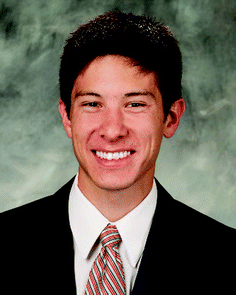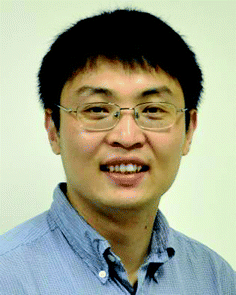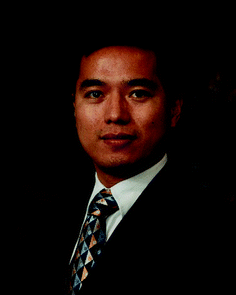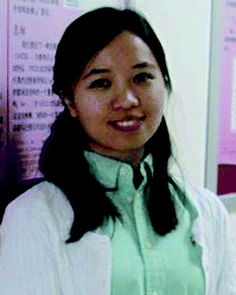DOI:
10.1039/C7TC90083J
(Profile)
J. Mater. Chem. C, 2017,
5, 5565-5571
Journal of Materials Chemistry C profiles: Contributors to the Emerging Investigators 2017 Issue
Trisha L. Andrew is an Assistant Professor of Chemistry and Materials Engineering at the University of Massachusetts Amherst. She started her independent career in 2012 at the University of Wisconsin-Madison, where she was an Assistant Professor of Chemistry and Electrical Engineering. She received her education at the University of Washington (BS) and at the Massachusetts Institute of Technology (PhD). Trisha is the Director of the Wearable Electronics Lab at the University of Massachusetts Amherst. The WEL Lab strives to produce emergent electronic technologies on unconventional substrates by using organic materials to achieve unmatched control over processing conditions, device dimensions and the spin of charge carriers. Trisha is a David and Lucille Packard Foundation Fellow and an Air Force Young Investigator and 3M Nontenured Faculty Award winner.
Christina Birkel is a junior research group leader in inorganic chemistry at the Technical University of Darmstadt exploring the non-conventional synthesis and magnetic properties of MAX phases. She received her PhD at the Johannes Gutenberg-University of Mainz in the group of Professor Wolfgang Tremel in 2010 working on antimonide nanoparticles for thermoelectric applications. She continued her research on thermoelectric materials focusing on bulk half-Heusler phases under the guidance of Professor Galen Stucky and Professor Ram Seshadri during her postdoctoral appointment at UC Santa Barbara (2011 to mid 2013). In 2013 she joined the group of Professor Barbara Albert to become a junior research group leader at TU Darmstadt. She has received several fellowships and awards (
e.g. the Feodor Lynen Research Fellowship of the Alexander von Humboldt foundation, MAINZ award for outstanding PhD thesis) and has independently raised diverse third-party funding (
e.g. German Research Foundation and Volkswagen AG). In her free time, she enjoys delicious food, inspiring books, exploring the world and staying active with her husband and two boys.
Kanishka Biswas obtained his MS and PhD degree from the Solid State Structural Chemistry Unit, Indian Institute of Science (2009) under the supervision of Professor C. N. R. Rao and did postdoctoral research with Professor Mercouri G. Kanatzidis at the Department of Chemistry, Northwestern University (2009–2012). He is an Assistant Professor in the New Chemistry Unit, Jawaharlal Nehru Centre for Advanced Scientific Research (JNCASR), Bangalore. He is pursuing research in solid state inorganic chemistry of metal chalcogenides, thermoelectrics, topological materials and 2D nanosheets. He has published 84 research papers, 1 book and 4 book chapters. He is a Young Affiliate of The World Academy of Sciences (TWAS) and an Associate of Indian Academy of Science (IASc), Bangalore, India. He is also the recipient of the Young Scientist Medal-2016 from the Indian National Science Academy (INSA), Delhi, India and the Young Scientist Platinum Jubilee Award-2015 from The National Academy of Sciences (NASI), Allahabad, India. He is recipient of the IUMRS-MRS Singapore Young Researcher Merit Awards in 2016.
Ou Chen has been an Assistant Professor in the Department of Chemistry at Brown University since 2015. He received his BS degree in chemical physics from the University of Science and Technology of China (USTC), and completed his PhD studies in the Department of Chemistry at the University of Florida. He was a postdoctoral associate working with Professor Moungi Bawendi at MIT. His current research interests focus on the development of novel methods for synthesizing and characterizing various nanocrystals and self-assembled superstructures, exploring their novel properties and potential applications.
Rubén D. Costa completed both his BSc/MSc studies (2006) and PhD (2010) in Chemistry at the University of Valencia (Spain). From 2011–2013, he was a Humboldt postdoc at the Friedrich-Alexander-University Erlangen-Nürnberg (Germany), where he has been a junior group leader since 2014. In 2017, he will start as a Senior Researcher at the IMDEA Materials Institute (Spain). Costa's research involves the development of new electroluminescent materials, nanocarbon-based hybrids, and bioinspired components for lighting, photovoltaics, and sensing applications. His academic/research achievements involve >85 scientific publications, 2 patents, as well as several authored/edited books. Recently, his research has been awarded the Spanish Young Chemist Award 2016 (RSEQ), the Silver Medal European Young Chemist Award 2016 (EuChemMS), the LpS Scientific Award 2016 and the ADUC 2017 (GDCh).
Junqiao Ding received his BS degree from Wuhan University of Technology in 1999 and gained his PhD degree from the Changchun Institute of Applied Chemistry, CAS, in 2007 under the supervision of Professor Lixiang Wang. After graduation, he joined the same institute as a research fellow and later was promoted to professor in 2014. During 2010–2011, he performed postdoctoral work at the University of New Mexico. His main interests are in the field of solution-processable organic optoelectronic materials and devices.
Eilaf Egap is an Assistant Professor in the Department of Chemistry at Emory University and the Wallace H. Coulter Department of Biomedical Engineering at the Georgia Institute of Technology and Emory University. She received her PhD degree from the University of Washington in 2011 in the field of organic electronics. She then moved to MIT as a postdoctoral fellow where she developed a new platform of multicomponent nanomaterials for diagnostics and imaging. Broadly, her group is interested in the molecular-engineering and self-assembly of functional soft materials with the goal of controlling and creating novel photonic, electronic and magnetic properties to enable new forms of technology.
Song Guo is a Nina Bell Suggs Assistant Professor in the Department of Chemistry and Biochemistry at the University of Southern Mississippi. He received his BS and MS from Nanjing University, China. He earned his PhD in physical chemistry from the University of Notre Dame under the supervision of Professor S. Alex Kandel. He did postdoctoral research with Professor Paul Barbara at the University of Texas at Austin and then with Professor Seth Marder at the Georgia Institute of Technology. His current research interests focus on the morphology–property correlation of low dimensional conjugated polymer aggregates and chemical doping of organic electronic materials. He is a recipient of the NSF CAREER award in 2016.
Geoffroy Hautier received his PhD in 2011 from the Massachusetts Institute of Technology (MIT) working under Professor Ceder's supervision. He was then a postdoctoral researcher from 2011 to 2014 working with Professor Gonze under a FNRS and Marie Curie fellowship. Since September 2014, he has been an Assistant Professor at the Université catholique de Louvain. His research group focuses on
ab initio computational materials design and high-throughput materials screening in various fields from Li-ion batteries to transparent conducting oxides and thermoelectrics.
Bharat Jalan is an Assistant Professor in the Department of Chemical Engineering and Materials Science at the University of Minnesota. Prior to his joining as a faculty member in 2011, he received his Bachelor in 2006 from the Indian Institute of Technology, Madras and his PhD in 2011 in Materials from the University of California, Santa Barbara. His research is focused on thin film synthesis, and the study of materials physics of complex oxide films and heterostructures. Among several awards, his most recent awards include an AFOSR Young investigator award (2016) and the biennial International MBE Young Investigator Award (2016). He has also been an active member of the materials community and has co-organized several leading national and international meetings.
Photo credit: Thor Balkhed, Linköping University
Magnus Jonsson is an Associate Professor at the Laboratory of Organic Electronics at Linköping University in Sweden. The research interests of his group span the broader area of organic and hybrid optoelectronic devices, with a focus on plasmonic and other nanooptical systems. The main application areas include energy conversion and biosensing. He holds a PhD in applied physics from the Chalmers University of Technology and a MSc in physics from Lund University, both in Sweden. Before joining Linköping University in 2014, he was a Wenner-Gren Fellow postdoc at the Kavli Institute of Nanoscience at the Delft University of Technology in the Netherlands. More info can be found at http://www.mpjonsson.com and at http://www.liu.se/LOE.
Wen-Yong Lai is a Full Professor at the Nanjing University of Posts and Telecommunications. He received his PhD from Fudan University in 2007. He then joined the Key Laboratory for Organic Electronics & Information Displays and Institute of Advanced Materials (IAM), Nanjing University of Posts & Telecommunications. His research mainly focuses on the design, synthesis, and application of organic and polymer optoelectronic materials for organic/plastic electronics. He is also interested in the exploration of novel materials and processes for printed electronics. So far, he has published over 110 SCI papers, which have aroused over 1900 SCI citations.
Psaras McGrier is an Assistant Professor in the Department of Chemistry and Biochemistry at The Ohio State University. He received his BS in Chemistry from the University of South Carolina–Aiken in 2004 and his PhD in Organic/Polymer chemistry from the Georgia Institute of Technology (Georgia Tech) in 2010 under the direction of Professor Uwe Bunz. After finishing his PhD, he moved to Northwestern University (2010–2013) to join the group of Professor Sir Fraser Stoddart as a postdoctoral scholar on a fellowship from the Georgia Tech Facilitating Academic Careers in Engineering and Science (FACES) committee and the National Science Foundation (NSF). His current research interests include the synthesis and photophysical characterization of 2D and 3D porous organic materials.
Yoann Olivier started a PhD thesis under the supervision of Dr Jérôme Cornil at the Laboratory for Chemistry of Novel Materials at the University of Mons and completed it in September 2008. From 2009 to 2013, he held a postdoctoral fellowship from FNRS (Belgian National Fund for Scientific Research) and went on postdoctoral stays with Professor Claudio Zannoni and Professor Henning Sirringhaus. His research interests deal with the understanding of electronic processes in organic conjugated and 2D materials, especially, charge transport using a multiscale approach combining quantum-chemical methods, a Monte Carlo approach and molecular dynamics simulations. Recently, he developed an interest in a new class of materials for organic light-emitting diodes exhibiting thermally activated delayed fluorescence, focusing on their electronic structure and energy transport properties.
Emanuele Orgiu earned his PhD title (grade: excellent) from the University of Cagliari (IT) in 2008 where he worked on the physics of charge transport in vacuum-sublimed organic semiconductors. In 2005, he was a visiting research scholar at the Institute of Semiconductor and Solid State Physics JKU Linz (AT) and Konarka GmbH where he worked on solution-processable polymer semiconductors and the charge transport physics thereof. In 2007, he was a Fulbright fellow at Santa Clara University, CA. After his PhD, he was a post-doctoral fellow at the National Institute of Matter Physics (INFM) before joining the Institute of Supramolecular Chemistry in 2009 as an Experienced Researcher Marie-Curie fellow. Since 2011, he has been Assistant Professor at the Department of Chemistry at the University of Strasbourg and Permanent Researcher at the Institute of Supramolecular Chemistry. In 2013, he received the MIT-Under35 France Award, which was awarded to the 10 most innovative individuals in France under the age of 35. In 2016 he also joined the EMT Centre (Institut national de la recherche scientifique) in Montreal (QC) as Associate Professor.
Henrik Pedersen received his MSc in Chemistry in 2004 and his PhD in Materials Science in 2008, both from Linköping University in Sweden. After a stint as an industrial researcher at the Sandvik Tooling Research and Development center in Stockholm, Sweden, he returned to academia and is today an Associate Professor in inorganic chemistry at Linköping University. He has, during the past decade, been exploring CVD for electronic materials, hard coatings and neutron detectors. His research is focused on understanding and developing new and better chemical vapor deposition methods where the aspect of time is carefully considered in various ways.
Emily Pentzer joined the Department of Chemistry at Case Western Reserve University in July 2013. She received a BS in chemistry from Butler University where her research included characterizing the squirrel population of central Indiana and identifying components of caramelized carbohydrates. She then earned her PhD in organic chemistry from Northwestern University (2010, Professor Sonbinh Nguyen), focusing on metathesis routes for preparing and polymerizing unsaturated lactones and lactams, followed by time as a postdoc researcher at UMass Amherst in Polymer Science with Professor Todd Emrick working on the synthesis and assembly of electronically active materials. Currently, her group uses organic synthesis to access new materials and assemblies as a route to understand structure–property relationships and access properties not possible with current state-of-the-art systems. She has received numerous awards including the NSF-CAREER award. She serves as Associate Editor for
Polymer Chemistry and publicity co-chair for the POLY Division of the American Chemical Society.
Sean T. Roberts received his BS in Chemistry from the University of California Los Angeles in 2003 and his PhD in Physical Chemistry from the Massachusetts Institute in Technology in 2010 for work using multidimensional infrared spectroscopy to study proton transport in liquid water with Andrei Tokmakoff. Starting in 2010, he worked as a NSF supported ACC-F postdoctoral fellow at the University of Southern California where he worked as a member of the Center for Energy Nanoscience under the guidance of Stephen Bradforth and Alexander Benderskii. In 2014, he started his independent career at the University of Texas at Austin where he leads a research group that uses and develops ultrafast spectroscopic techniques to understand how the mesoscopic ordering of semiconductor nanomaterials impacts their ability to manipulate energy and transport charge. He is a recent recipient of the NSF CAREER award, and has won funding from the Air Force Office of Scientific Research, American Chemical Society Petroleum Research Fund and Robert T. Welch Foundation. In 2014 he received the Natural Sciences Foundation Teaching Award and currently heads an ACS and NSF-funded outreach program targeted at increasing community college student participation in science.
Bryce Sadtler earned a BS degree in Chemistry from Purdue University in 2002. He conducted his graduate work at the University of California, Berkeley under the guidance of Paul Alivisatos, where he developed chemical transformations in colloidal semiconductor nanocrystals. He received a PhD in Physical Chemistry in 2009. He was then a Beckman Postdoctoral Fellow at the California Institute of Technology, where he worked with Nathan Lewis to develop light-driven growth processes in inorganic nanostructures. He joined the Department of Chemistry at Washington University in St. Louis in the fall of 2014. His research interests include solid-state chemistry and light–matter interactions at the nanoscale for applications in solar energy conversion and catalysis.
Abel Santos received his BEng in Chemical Engineering from the Universitat Jaume I (Spain) in 2006, and MEng and PhD degrees in Electronic Engineering from the Universitat Rovira i Virgili (Spain) in 2007 and 2011, respectively. In 2014 he was awarded an ARC-DECRA, and currently he is a Research for Impact Fellow in the School of Chemical Engineering, member of the Institute for Photonics and Advanced Sensing (IPAS) and Associate Investigator of the ARC Centre of Excellence for Nanoscale BioPhotonics (CNBP) at the University of Adelaide, where he works on structural engineering of photonic crystals based on nanoporous anodic alumina.
Chih-Jen Shih has been a tenure-track Assistant Professor of chemical engineering at the Department of Chemistry and Applied Biosciences, ETH Zurich since May 2015. He received his PhD degree from the Massachusetts Institute of Technology (USA, 2009–2014). Prior to joining the faculty at ETH, he served as a postdoctoral researcher at Stanford University. He started the Laboratory for Interface and Surface Engineering of Nanomaterials (LISE) in the Institute for Chemical and Bioengineering (ICB) in 2015. The LISE is focused on the following directions: multiscale modelling of nanomaterials, physics and chemistry at nanomaterials interfaces, nanomaterials processing and nanomaterials-based devices.
Daniel Shoemaker is an Assistant Professor in Materials Science and Engineering at the University of Illinois at Urbana-Champaign. He joined the faculty at Illinois in 2013 after a postdoctoral appointment in the Materials Science Division at Argonne National Laboratory. He received his BS in Materials from Illinois in 2006 and his PhD in Materials from the University of California, Santa Barbara in 2010.
Yong Sheng Zhao received his PhD degree in 2006 at ICCAS. After that, he joined the University of California at Los Angeles (UCLA) and Northwestern University as a postdoctoral fellow. In 2009, he returned to ICCAS as a Professor of Chemistry. He is currently a Fellow of the Royal Society of Chemistry (FRSC), who was recognized as the winner of the ChemComm Emerging Investigator Lectureship 2015. His research interests are focused on organic nanophotonic materials and devices, including the controllable fabrication of low-dimensional organic materials, organic microscale lasers, as well as the construction of photonic integrated devices.
Yuebing Zheng joined the University of Texas at Austin as an Assistant Professor of Mechanical Engineering and Materials Science and Engineering in 2013. He did his postdoctoral research with Professor Paul S. Weiss at the University of California, Los Angeles from 2010 to 2013. He received his PhD from the Pennsylvania State University under the guidance of Professor Tony Jun Huang in 2010. His group exploits the synergy among nanophotonics, microfluidics and colloid and surface chemistry to innovate optical technologies. Research projects range from advancing the fundamental understanding of light–matter interactions at the nanoscale to developing and applying optically active materials and devices.
Huanping Zhou is an Assistant Professor in the Department of Materials Science and Engineering, Peking University, with a joint affiliation in the Department of Energy and Resources Engineering. She received her PhD from Peking University, College of Chemistry and Molecular Engineering in 2010. She then joined the University of California at Los Angeles (UCLA) as a Postdoc fellow (2010–2015). Her research interests include perovskite solar cells, thin film optoelectronics, and nanostructured energy materials. She has co-authored ∼60 peer-reviewed papers (30+ publications on perovskite materials/devices with over 5000 citations) and is the inventor of two patent publications.
|
| This journal is © The Royal Society of Chemistry 2017 |

